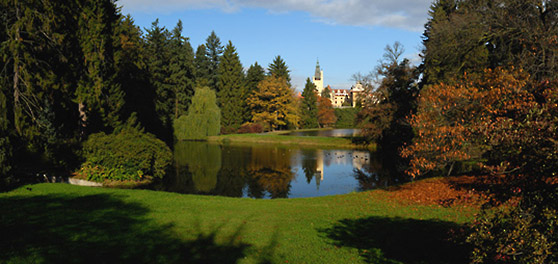
Průhonice Park was established 125 years ago by Count Silva-Tarouca
 |
Prague - Business card of the Průhonický Park, which, according to a recent decision by the UNESCO committee, is assigned to the Prague Heritage Reserve and therefore under UNESCO protection, on the list of which the historical core of Prague has been listed since 1992:
- The park is a unique nature-landscape work of European significance. It lies in the rugged valley of the Botič stream, which is supplemented by numerous ponds. In addition to the original domestic tree species, there are numerous exotic plants growing here - about 1500 taxa and cultivars of trees and 600 taxa and cultivars of perennials. The charm of the park is enhanced by various vistas, viewpoints, and open meadows, as well as groupings of trees that utilize their colorful variability in different seasons. On the cliffs above the stream is a vast Alpine garden (65,000 m²).
- Among the plant species, the local rhododendrons attract the most attention, appealing to visitors during the blooming period. There are about 8000 specimens in 100 taxa and cultivars here.
- The park is also a refuge for numerous animal species that come here from the surrounding landscape marked by extensive construction.
- The park covers an area of 250 ha and is intersected by about 23 km of park paths.
- The park also includes valuable genetic resource collections and a conifer cone collection.
- The park was founded by the owner of the Průhonice estate, Count Arnošt Emanuel Silva-Tarouca, in 1885 and was developed practically until his death in 1936.
- Inspirations for the park's construction for Silva-Tarouca came from a park at the family estate in Čechy under Košíř in the Prostějov area, and mainly the famous park of Prince Pückler-Muskau in Bad Muskau on the present-day German-Polish border.
- In addition to the park, Silva-Tarouca, who acquired the estate in 1885 through marriage to Countess Marie Antonie Nosticová-Rienecková, was also responsible for the reconstruction of the adjacent castle. From 1889 to 1894, he gave it the current Neo-Renaissance appearance. The castle, which is not open to the public (it houses the Botanical Institute of the Czech Academy of Sciences), is among other things a popular backdrop for filmmakers.
- Part of the Průhonický castle complex is also the valuable Romanesque church of the Nativity of the Virgin Mary.
- In 1927, Silva-Tarouca sold the Průhonice estate, including the park, to the Czechoslovak state. The park is now managed by the Botanical Institute of the Academy of Sciences, where a botanical garden was established in Průhonice in 1963.
- Průhonický Park and the castle are national cultural monuments, and the park is listed in the inventory of historic gardens of the international organization ICOMOS.
The English translation is powered by AI tool. Switch to Czech to view the original text source.
0 comments
add comment










